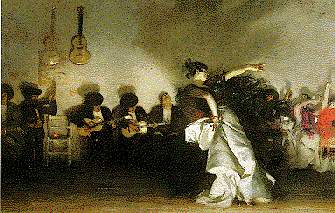
H I S T O R Y

¡@
Flamenco, contrary to general belief, is not the musical folklore of Spain, but an art-form that originated in the southern part of Spain known as Andalucía. Its homeland is broadly-speaking defined by a triangle formed by the cities of Córdoba, Sevilla and Cádiz. Although most American and North Europeans think of Flamenco principally as a flamboyant form of dance, in reality it comprises three elements, the song (el cante), the dance (el baile) and the guitar (el toque) which serves either as an accompaniment to the song and dance or, more recently, as an art-form in itself. While flamenco has become a highly commercial enterprise, it is still a way of life for many and is the natural basis for expressing feelings. It is usually at its best in a spontaneous form not easily achieved in concert halls or festivals.
Origination: Flamenco originated among the gypsies of Andalucía over several centuries and probably achieved a concrete form around the end of the 17th century as an unaccompanied song which, much like the blues, was an expression of poverty, oppression and personal grief. The music incorporated many elements offered by the disparate peoples who had gravitated to the fertile and gentle region of Andalucía whose name derives from the Moorish term for this area, Al-Andalus. The gypsies themselves came from India in a series of migrations around the 12th century. After wandering through central Europe a group of them arrived in Southern Spain probably sometime in the 14th century bringing with them their own language (now known as 'Romano' or 'calé') and an oriental-based music. To this day, flamenco clearly shows signs of its oriental origins in the use of non-Western chord structures and progressions. Over the centuries the gypsies incorporated elements from other inhabitants of the region, especially from the Moors and the Jews. Since the gypsies were largely social outcasts, mistrusted and despised by most and subject to special laws and arbitrary treatment, they retained an insular way of life and their music remained quite distinct from the mainstream Spanish folk music. For much of their history they were unable to own property and worked at menial labors such as in agriculture or in the mines. Some used their talents as blacksmiths or jewellers to earn a modest living. At this time flamenco was performed in the home in informal gatherings of close family and friends or occasionally as work songs in the mines and smithies. The cantes reflected this fact in their personal nature, expressing the hardships of life and general misery. In this and their dependence on improvisation they resemble the blues of African Americans under comparable circumstances.
Earlier...In its early form flamenco evolved solely as a personal form of expression, sung in the home for immediate family and friends.
Themes¡KThe most primitive forms (deblas, martinetes, siguiriyas and soleá) still deal only with unhappiness (death, lost love, hardship). With time flamenco also became a means of expressing happiness as it incorporated elements of Spanish music in lighter forms (alegrias, bulerias, fandangos). The introduction of the guitar probably accelerated this as did the development of the dance in the last century. Towards the end of the last century flamenco song and dance (el cante y el baile) entered the commercial arena. Initially some artists were hired by rich patrons to sing in 'juergas' or parties. This led to the evolution of 'professional' artists and culminated in the period of the 'cafes cantantes' where flamenco could be heard in public. This evolution also led to changes in the nature of the songs as fads developed for particular types of cante. Many of the more primitive forms languished and some were totally lost while others - especially the fandangos - achieved tremendous popularity. Growing commercialization continued spasmodically until the 1950s when the influx of tourists to post-war Spain threatened to bastardize the art form completely. In part thanks to Antonio Mairena, an excellent singer and gypsy from Mairena Del Alcór a group of artists (including José Menese, Fosforito, El Chocolate, Enrique Morente and El Terremoto de Jerez) rediscovered the older forms and re-established interest in flamenco as an art form as well as a commercial form of music. This process depended in part on memories of older amateur singers such as Juan Talega and Manolo Caracol. This revival was accompanied by the establishment of many 'Festivales de Flamenco' during the 1960s and 70s. Although some regard these as having stifled the intimacy and spontaneity of flamenco they undoubtedly opened up the art to a wider public and provided opportunities for new artists.
¡@